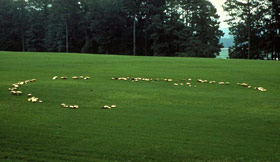Fairy Ring (Basidiomycetes)

From Fairy Ring on Turfgrass, Cornell University Plant Pathology & Plant Microbe Biology. Photo by Eric B. Nelson, Cornell University.
IPM Steps to Reduce Fairy Ring
1. Sample for Pest
Confirm the presence of fairy ring before you treat.
Where to find it while inspecting: Can be found on most healthy turfgrasses. Look for rings of dark green growth or in some cases, rings of mushrooms.
2. Proper ID
Is it fairy ring?
Size and Appearance: 1 ft to 100 ft in diameter. May be complete or incomplete circles.
3. Learn the Pest Biology
What is the life cycle of fairy ring?
Life Cycle: Fairy rings are caused by related fungus and do not always have the same tendencies. Rings develop from the breakdown of organic matter in the soil; the new organic matter stimulates a release of nitrates that stimulate turfgrass. Each year the fungus spreads out, increasing the ring’s diameter. In some cases, can kill turfgrass in the “ring”.
Preferred Food Sources: Fungal diseases obtain nutrients through the breakdown of organic matter—in this case turfgrass plant cells.
Preferred Habitat: Any mowed turf area—actually active on drier turfs than wet, and in drier periods in summer and fall.
4. Determine Threshold
How much fairy ring is too much?
Threshold: Threshold is generally high unless there is an aesthetic concern on high-end turf.
5. Choose Tactics
Creating a healthy soil condition and understanding turfgrass’s needs is the first step in reducing turf pests. What can I do to treat, reduce, or prevent Rust Diseases of Turf?
Best Management Practices: Because this is a fungus that lives in soil and becomes active when others would be dormant, it is rather difficult to prevent. To mask dark rings in aesthetically important turf, you can fertilize with N to boost the color of the rest of the turf. In extreme cases, excavation of soil and reestablishment of turf is an option. Fairy ring is not usually damaging so most people choose to tolerate it.
Treatment Methods: Any thought to treatment with fungicides must be done with extreme care to timing, and awareness that due to the nature of the fungus you may not have complete success in preventing a return.
6. Evaluate
Was the tactic successful? Record the date pests were first noted, and the tactic you used, and its success. Use one of our RECORD KEEPING tools
For More Information:
University of Illinois IPM: Fairy Rings, Mushrooms, and Puffballs
Remember:
When a pesticide application is necessary, all necessary and required precautions are taken to minimize risk to people and the environment and to minimize risk of pesticide resistance or pest resurgence. Pesticide use in your school may be prohibited or regulated by local policies or state and federal regulations. Risk reduction methods can include, but are not limited to, spot-treatment, the use of gel or paste bait formulations placed in inaccessible locations, injection into a crack or crevice, and other methods that reduce potential exposure.